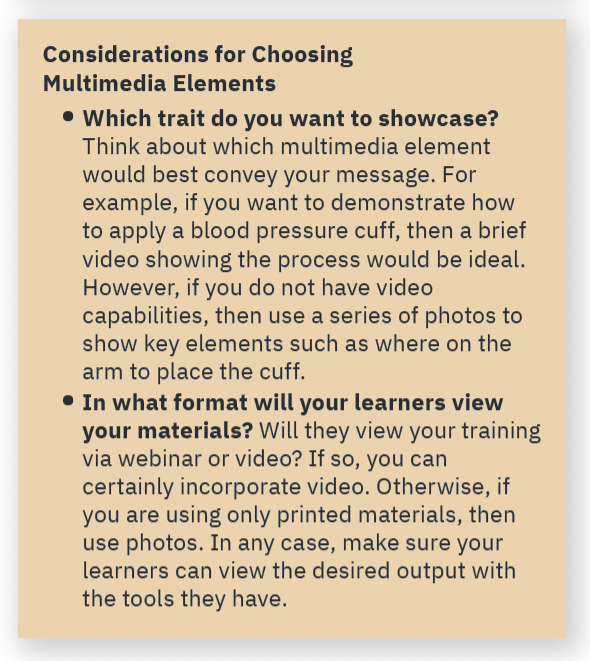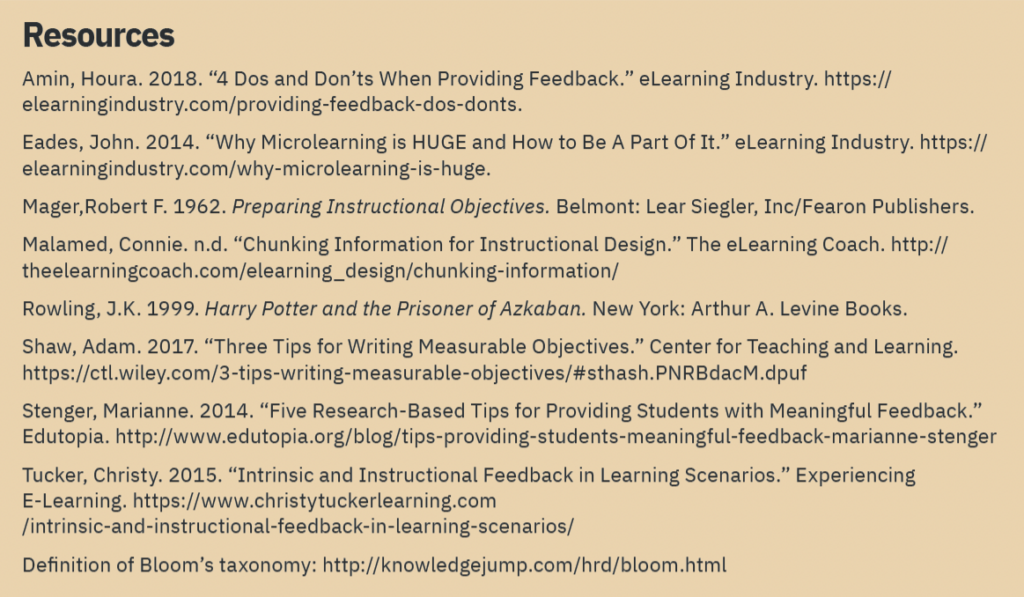By Jamye Sagan | STC Associate Fellow
Channel your inner wizarding professor to develop clear and effective lessons.
As technical communicators, we stand ready to tackle any project we receive, including developing training materials and programs, even if we had never formally studied instructional design. Education plays a crucial role in the Harry Potter series by J.K. Rowling. At Hogwarts, where Harry Potter and his friends study magic, we witness several examples of instruction in action. Each professor — whether terrible or terrific — has important lessons to share with us regarding effective instructional design and training delivery. One particular professor embodies elements of excellent instruction — Remus Lupin, the Defense Against the Dark Arts teacher during Harry’s third year at Hogwarts. With his patient and encouraging manner, Lupin successfully teaches his students how to defeat evil creatures.
Let’s peek into Professor Lupin’s classroom to learn five tips for designing effective instruction for our learners.
Background: Lupin’s Class
Lupin teaches his students how to fight boggarts, creatures that physically embody one’s deepest fear. In teaching his class this complex charm, he breaks the process into manageable components to ensure his students completely understand what they need to do.
First, Lupin introduces the lesson with several leading questions to gauge what the class already knows about boggarts. After establishing that knowledge base, he then has the class practice saying the charm aloud. Once the students can chant the incantation properly, Lupin invites a student to help him demonstrate the entire spell. Lupin guides his student through the process of making his greatest fear look comical –the expected outcome of the spell and the lesson. With Lupin’s encouragement, the student performs the charm successfully. Finally, Lupin invites the rest of the class to practice the charm, offering feedback to ensure students perform the spell correctly.
Tip #1: Define Learning Objectives
After receiving an instructional design request, one of the first and most important actions to take is defining learning objectives. What do learners NEED to know and do after receiving training? Learning objectives serve as the major driving force behind the entire course development cycle.
When differentiating between essential and optional information, consider the Pareto principle: what will folks spend 80 percent of their time doing? Focus these energies on that 80 percent. Once you determine what the learners need to know, you can begin crafting your learning objectives. Cut all “nice to know” information from the training; you can always provide this optional information as reference material elsewhere. Having clear-cut goals and objectives will help you keep the training on track since you have already defined what you want your learners to know.
Learning objectives must be specific, measurable, and tangible – that they can be seen, felt, or heard. How can you create solid learning objectives? In his book Preparing Instructional Objectives, Robert Mager proposes three questions to ask:
- What is the desired outcome? In other words, what behavior needs to happen?
- Under what conditions must the action take place to achieve the desired outcome?
- What is considered success? That you perform correctly X percent of the time, or can do it at least?
When crafting learning objectives, use verbs that describe a specific action. Refer to Bloom’s Taxonomy for examples of measurable verbs to use.
Lupin embodies this tip when designing his boggart lesson. Before even launching into the practical portion of his lesson, he explained what boggarts are, where they came from, and what they looked like so students could properly identify them and use the correct spell.
Tip #2: Chunk Content into Manageable Pieces
Once you define what your learners need to know, you can begin gathering content. As you gather and curate content, chunk it. Chunking content means breaking it into smaller pieces and later rearranging these pieces into logical units. Doing so makes information easier to digest. No matter the training format (e.g., e-learning or instructor-led), break up the content into several related modules.
 Chunking information ensures you present only the information covered in the learning objectives. Chunking training content also simplifies course updates; you only have to update the small chunk versus the entire course. Besides. if you present too much information to your learners at once, they may get overwhelmed and start tuning out information — cognitive overload. A good rule of thumb is scheduling no more than 15 minutes per module or activity.
Chunking information ensures you present only the information covered in the learning objectives. Chunking training content also simplifies course updates; you only have to update the small chunk versus the entire course. Besides. if you present too much information to your learners at once, they may get overwhelmed and start tuning out information — cognitive overload. A good rule of thumb is scheduling no more than 15 minutes per module or activity.
Lupin demonstrates this tip by how he breaks down his entire lesson into smaller segments. He gauges his students’ prior knowledge about boggarts. Then he has them practice saying the incantation. After that, he leads a guided demonstration of the spell with a student before allowing the rest of the class to practice. Lesson chunking ensured the students could perform this spell successfully.
Tip #3: Craft Content with Sensory Appeal
Now that you have organized your content into manageable chunks, you can now format that content accordingly. When possible, show rather than tell. Incorporate a variety of activities and into your lesson.
While lectures are effective for conveying information, they quickly lose impact if they don’t engage as many senses as possible. Include such elements as images, video clips, graphs, charts, and other audio/visual elements. Better yet, don’t depend solely on lectures to convey information. Include group discussions, exercises, and other activities that invite participation. Use multimedia elements to make your lessons come to life.
yet, don’t depend solely on lectures to convey information. Include group discussions, exercises, and other activities that invite participation. Use multimedia elements to make your lessons come to life.
Lupin embodies this tip with his guided demo of the spell. The students hear Lupin explain the steps and the expected outcomes. When Lupin has Neville identify his greatest fear (Professor Snape) and mentally picture something that would make Snape look odd (ostentatious vulture hat), the students see the spell in action. The boggart takes the shape of Snape. As Neville performs the spell, boggart-Snape now wears the vulture hat and no longer poses a threat.
Tip #4: Establish a Risk-Free Environment for Practice
When needed, give learners a chance to practice their skills in a risk-free environment. Examples include pre-developed scenarios and software demonstrations, like those shown in Lene Thirup’s article, “Train the People Who Keep Our Industrial World Running,” on page 21.
When developing practice scenarios or hands-on training, focus on the most important and/or complex topics first. How can learners practice what they have just learned? For instance, in e-learning courses, create software simulations or branching scenarios. For instructor-led sessions, set up a testing environment with pre-defined exercises and scenarios. All practice activities MUST align with learning objectives. Otherwise, they are simply a waste of time and do not effectively convey what your learners need to know. Setting up practice opportunities may take extra time in advance but are well worth the effort.
Lupin sets us his practice environment by searching the castle for a boggart, which he then stores in the class cabinet until the class begins. The boggart can easily assume different shapes. Plus, during the group practice session, Lupin abruptly stops the lesson when Harry begins his practice session. Lupin did so to prevent the boggart-Voldemort from appearing. Although Harry later revealed that Voldemort was not his greatest fear, Lupin still took the correct action in preventing any potential pandemonium from breaking out.
Tip #5: Give Effective Feedback
Finally, as you deliver your training materials and witness your learners in action, giving feedback not only provides encouragement but also helps in skills development. Whether given verbally or written, feedback must be specific to be most effective. Instead of murmuring “Good job!” or shouting “Wrong!” give a reason and explain why. For example, when developing e-learning courses, I incorporate several “Test Your Knowledge” questions throughout the course. I base these questions on the defined objectives and provide specific feedback. When the learner answered the question, they would immediately know if they answered correctly or not, and more importantly, why. Meaningful feedback helps learners validate their strengths and identify areas of opportunity.
Lupin demonstrates this tip by observing the class and offering feedback to make sure they perform the spell correctly. Also, when another teacher makes fun of Neville’s abilities, Lupin expresses his confidence in Neville’s future performance.
 Conclusion
Conclusion
Through his lesson in defeating boggarts, Professor Lupin demonstrates effective instruction and solid instructional design. First, Lupin determines his learning objectives and sticks with them throughout the lesson. Second, he organizes his lesson into several different parts so the students can learn about boggarts and effectively practice the spell. Third, Lupin uses a variety of activities to keep the students’ interest, from a Q&A session to practicing saying the spell aloud. Fourth, Lupin establishes a risk-free environment to allow his students to practice the spell. Finally, Lupin offers feedback to ensure students perform the spell correctly.
From asking questions to gauge what the class already knows about boggarts, to demonstrating the spell bit by bit, to having the class take turns practicing the spell, Lupin clearly embodies how effective instructional design can help learners achieve their goals. We can apply these lessons to our own practice, even if we are not experienced training developers.

JAMYE SAGAN (jamye.sagan@gmail.com) serves as the pharmacy communication advisor for H-E-B and helps design training programs and materials for various projects and initiatives in the pharmacy department. She also manages communications between the corporate office and the store pharmacies. An STC Associate Fellow, Jamye is the current president of the South Central Texas chapter and treasurer for the Instructional Design & Learning SIG. She also serves at the Society level with the Community Affairs Committee and has been part of several other Society-wide committees. When not making “sense out of the seemingly senseless” in the tech comm world, Jamye enjoys transforming yarn into pretty and useful objects. She lives in San Antonio, TX.



